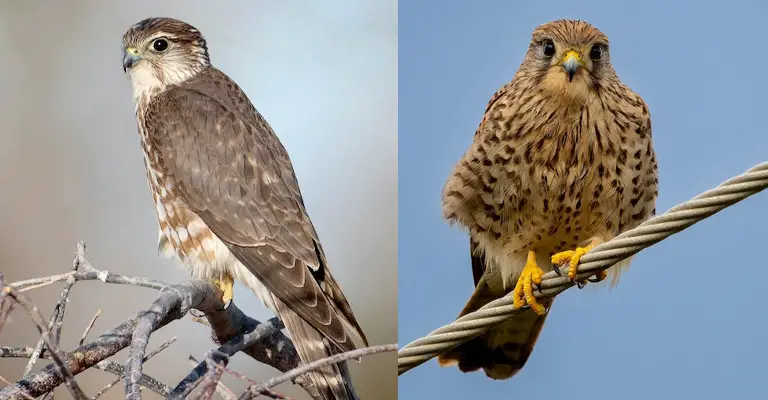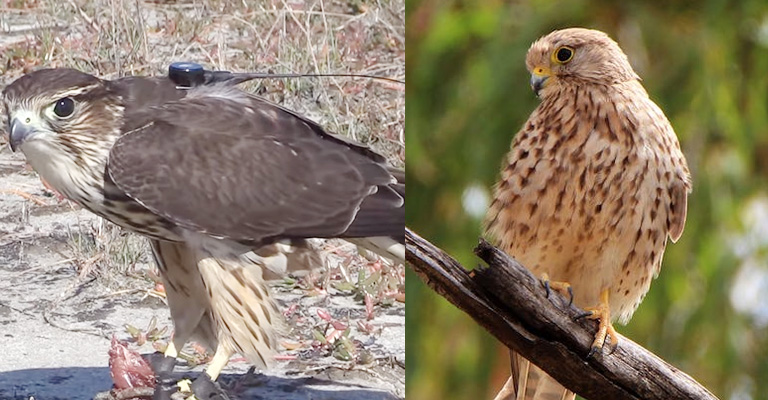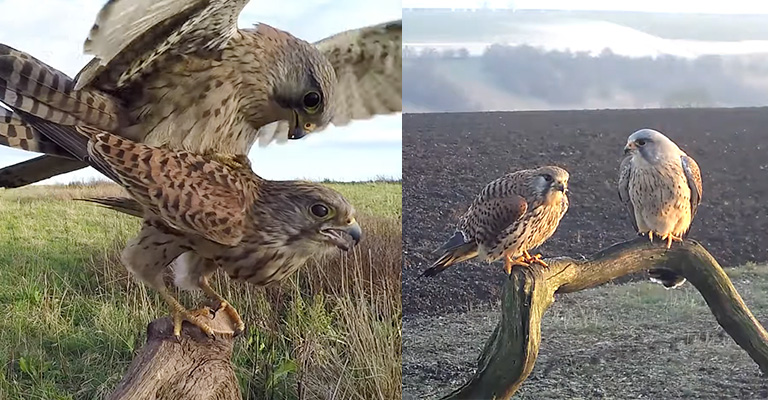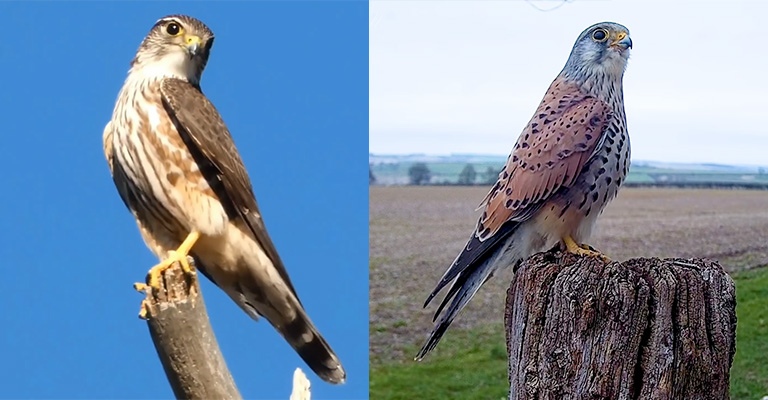The rivalry between Merlin and Kestrel is a captivating tale that unfolds in the world of birds of prey. These two magnificent creatures, known for their remarkable hunting skills and aerial prowess, have long been pitted against each other in a battle for dominance and survival.
While both Merlin and Kestrel belong to the Falcon family, they possess distinct characteristics and strategies that set them apart. And that makes it difficult to figure out their differences in many cases.
In this introduction, we will delve into the unique qualities of each bird and explore the fascinating dynamics of the Merlin vs Kestrel rivalry.

Physical Characteristics
The quickest way to differentiate a merlin and a kestriel is to check their physical appearance. Though they share a lot of similarities, they are not the same in the following contexts.
Size and Body Shape
American Kestrels are smaller and more slender compared to Merlins. Kestrels typically measure around 9 to 12 inches in length, while Merlins are slightly larger, ranging from 10 to 13 inches.
In terms of body shape, Kestrels have a more compact and rounded appearance, whereas Merlins have a chestier and stockier build.
Coloration and Plumage
Both species display beautiful plumage, but their coloration differs significantly. American Kestrels exhibit a range of colors, with males sporting a combination of rusty red, blue-gray, and white on their wings and back, while females have a more subdued brownish coloration.
In contrast, Merlins have darker plumage, primarily dark brown or grayish-brown, with faint streaking on their underparts.
Facial Features and Markings
Facial features play a crucial role in distinguishing between American Kestrels and Merlins. Kestrels have a distinct face pattern characterized by two bold “mustache” stripes, one above and one below their eyes.
These markings give them a strong and defined appearance. In contrast, Merlins lack these mustache stripes, and their faces have a cleaner, less patterned look.
Instead, Merlins often have a white stripe above their eyes, which adds to their fierce and intense expression.
Tail and Wing Structure
The structure of the tail and wings provides further clues for differentiating between Kestrels and Merlins. Kestrels have longer tails relative to their body size, which gives them a more elongated appearance when in flight.
Their tail feathers typically display darker, finer bars, except for the broader bar near the tip. On the other hand, Merlins have relatively longer and pointier wings, enhancing their agility and speed during flight.
Their tails usually exhibit evenly barred patterns, with lighter bars on a brown base.
Habitat and Distribution

Besides their physical appearance, Kestrel and Merlins have some dissimilarities in their habitats and distributions. The following points will help you understand the facts properly.
Range of American Kestrels
American Kestrels have a widespread distribution across North and South America. They are the most common falcon species in North America and can be found throughout the continent, from Canada to as far south as Argentina.
Their range extends from coastal regions to open grasslands, agricultural fields, and even urban areas. American Kestrels are known for their adaptability to various landscapes, including forests, deserts, and marshlands, making them versatile hunters in diverse ecosystems.
Range of Merlins
Merlins have a more circumpolar distribution compared to American Kestrels. They breed in northern regions of North America, Europe, and Asia, including Alaska, Canada, Scandinavia, and Russia.
During the winter, Merlins undertake migratory journeys and can be found in more southerly regions. In North America, they may migrate as far south as Central America and the Caribbean.
Merlins typically favor open habitats, such as moorlands, tundra, and taiga, where they can find suitable prey and nesting sites.
Preferred Habitats and Ecological Adaptations
American Kestrels show a preference for open habitats with abundant perching and hunting opportunities.
They are often found in grasslands, agricultural areas, and along roadside wires and posts, where they can spot their prey, primarily small mammals, insects, and small birds.
Their ability to adapt to human-altered landscapes, including suburban areas and urban parks, has contributed to their widespread presence.
Merlins, on the other hand, is closely associated with a mix of open and semi-open habitats. They thrive in diverse ecosystems such as coastal areas, heathlands, taiga, and montane forests.
Merlins have a remarkable adaptation for pursuing avian prey, often targeting small songbirds and shorebirds during their hunts. Their swift flight and agility enable them to navigate through dense vegetation and pursue agile targets.
Hunting and Feeding Behavior

These two beautiful species don’t follow the same strategies while hunting and feeding. In this context, they share some similarities too. These points can enclose the fact clearly.
Hunting Techniques and Prey Preferences
American Kestrels are opportunistic hunters, utilizing a variety of hunting techniques to capture their prey. They employ a sit-and-wait strategy, perching on elevated positions such as tree branches, telephone poles, or wires, scanning the surroundings for potential prey.
Once they spot their target, they swiftly launch themselves into the air and use their powerful wings and sharp talons to seize their prey mid-flight. Kestrels primarily feed on small mammals, such as mice, voles, and shrews, as well as insects and small birds.
Merlins, known for their exceptional speed and agility, employ a more active hunting style. They engage in aerial pursuits, chasing their prey in swift and acrobatic flights.
They are highly skilled at maneuvering through intricate habitats, such as dense forests or shrubby areas, where their prey seeks cover.
Their primary prey consists of small to medium-sized birds, including songbirds, shorebirds, and occasionally bats and insects.
Speed and Agility in Flight
Both American Kestrels and Merlins are renowned for their speed and agility in flight. American Kestrels can hover in mid-air, a behavior unique among falcons, allowing them to observe the ground below and spot prey with precision.
When they initiate their hunting dive, called a “stoop,” they can reach impressive speeds, diving at their prey with remarkable accuracy.
Merlins, often considered one of the fastest birds in level flight, can reach astonishing speeds when pursuing their prey. Their streamlined body and long, pointed wings facilitate rapid aerial pursuits, enabling them to catch agile songbirds in mid-flight.
Their ability to make sudden turns and rapid changes in direction showcases their exceptional agility during the hunt.
Feeding Habits and Hunting Strategies
American Kestrels and Merlins exhibit specific feeding habits and hunting strategies. Kestrels tend to consume their prey immediately after capture, either consuming it on the ground or carrying it to a nearby perch. They tear their prey apart with their sharp beaks and consume them in bite-sized portions.
Merlins, on the other hand, often consume their prey on a secure perch after capturing it. They pluck feathers and tear off edible portions before consuming their catch. They may also cache food, storing excess prey in hidden locations for later consumption.
The hunting and feeding behavior of American Kestrels and Merlins highlight their adaptability, precision, and specialized skills as falcons. Their unique strategies and prey preferences contribute to their success as skilled hunters in their respective habitats.
Breeding and Reproduction

Merlin and Kestrel are not the same when the point is breeding and reproduction. In such cases, the following factors are very important to consider.
Mating Rituals and Courtship Displays
Both American Kestrels and Merlins engage in elaborate mating rituals and courtship displays to attract a mate. Male kestrels perform impressive aerial displays, soaring high in the sky while executing acrobatic flights, fluttering their wings, and calling out to potential mates.
They may also offer prey items to the female as a courtship gift.
Male Merlins showcase their flying prowess during courtship by performing rapid and intricate flight patterns, including steep dives and twists, often accompanied by vocalizations.
These displays not only serve to impress the female but also establish the male’s fitness and ability to provide for the upcoming nesting period.
Nesting Habits and Nest Site Preferences
American Kestrels and Merlins exhibit different nesting habits and preferences. Kestrels are cavity nesters, utilizing natural cavities in trees, abandoned woodpecker holes, or man-made structures such as nest boxes.
They line their nests with materials like grass, leaves, and feathers. Kestrels often select nesting sites that offer a clear view of the surrounding area, providing them with an advantageous vantage point for hunting and defending their territory.
Merlins, on the other hand, typically build their nests in dense vegetation or coniferous trees, often near the forest edge or in open habitats.
They construct a cup-shaped nest using twigs, grass, and other plant materials, lining it with softer materials such as moss or feathers.
The nesting sites are usually concealed and provide protection for their eggs and young.
Incubation Period and Raising of Young
After mating, female kestrels and merlins lay a clutch of eggs, typically ranging from 3 to 7 eggs, depending on the availability of food resources.
The incubation period for both species lasts around 28 to 32 days, with the female primarily responsible for incubating the eggs. The male assists in providing food for the female during this period.
Once the eggs hatch, both parents are involved in the care and feeding of the young. They diligently bring food to the nest and regurgitate it for the nestlings. The young falcons grow rapidly, and within a few weeks, they become more active and begin to exercise their wings in preparation for their first flights.
As the young falcons develop their flight and hunting skills, the parents gradually reduce their provisioning and encourage the juveniles to become independent. Eventually, the young kestrels and merlins leave the nest and embark on their own journeys.
The breeding and reproductive behaviors of American Kestrels and Merlins highlight the intricacies of their species-specific adaptations and parental care strategies, ensuring the survival and continuity of these magnificent falcons.
Vocalizations and Communication

If you somehow fail to find out the bird or it is out of your sight, there are ways to find them out just by listening to their calls. Here is how you can identify their vocals.
Unique Calls and Vocal Repertoire of American Kestrels
American Kestrels have a diverse vocal repertoire consisting of several distinct calls. Their most recognizable call is a loud, high-pitched “Klee” or “klee-ee” sound, often repeated in rapid succession.
This call is commonly used during territorial disputes, mate attraction, and communication between individuals. Additionally, kestrels produce a series of shrill screams and chatter-like vocalizations when they feel threatened or agitated.
The female kestrel also emits a unique call during courtship displays, which can be described as a rapid, high-pitched “klee-klee-klee.”
Vocalizations and Communication Behaviors of Merlins
Merlins communicate through a combination of vocalizations and body language. Their vocal repertoire includes various calls and vocalizations that serve different purposes.
Merlins emit a sharp, piercing “kek-kek-kek” call, often used during territorial disputes or to communicate with their mate or young. They also produce high-pitched, chattering calls during courtship displays or when agitated.
Furthermore, merlins engage in wing-waving displays and aerial acrobatics as visual signals to communicate their intentions or defend their territory.
Both American Kestrels and Merlins use vocalizations to establish and defend their territories, communicate with their mates during courtship and breeding, and convey warnings or distress signals.
These vocalizations and communication behaviors are essential for maintaining social bonds, coordinating hunting efforts, and resolving conflicts within their respective populations.
Conservation Status
These two species have some differences in their conservation status as well. The following factors will help you understand their differences.
Threats and Challenges Faced by American Kestrels
American Kestrels encounter several threats throughout their range. Loss and fragmentation of suitable habitat due to urbanization, agricultural expansion, and the conversion of grasslands and open spaces pose significant challenges for kestrel populations.
Additionally, the use of pesticides, such as organochlorines, can have detrimental effects on their reproductive success and overall health. Competition for nest sites with invasive species, such as European Starlings, further compounds the challenges faced by kestrels.
Conservation Efforts and Initiatives
To address the threats to American Kestrels, various conservation efforts and initiatives have been implemented. These include the establishment and monitoring of nest box programs to provide additional nesting sites, particularly in areas where natural cavities are limited.
Conservation organizations and researchers also conduct surveys and research projects to gather data on population trends, breeding success, and migratory patterns.
Conservation Status of Merlins and Relevant Concerns
Merlins, like American Kestrels, face specific conservation concerns. Loss and degradation of habitat, particularly the loss of suitable nesting sites in mature forests, can impact merlin populations.
The conversion of forests into agricultural land, deforestation, and logging activities can disrupt their nesting and foraging habitats. Climate change and its associated effects, such as altered prey availability and shifting migratory patterns, also pose challenges for merlins.
Conservation efforts for Merlins involve habitat conservation and management practices that prioritize the protection of nesting sites and the preservation of diverse and healthy ecosystems.
Birdwatching and Identification Tips
Here are some essential tips that will help you to identify birds easily. Make sure to remind it properly.
Field Characteristics for Distinguishing Between American Kestrels and Merlins
Size and Body Shape
American Kestrels are smaller and more slender compared to Merlins, which have a slightly larger and stockier appearance.
Coloration and Plumage
Kestrels exhibit a paler overall coloration, including their back and underparts, while Merlins tend to be darker in color. Kestrels also have distinct black “mustache” stripes on their face, which Merlins lack.
Facial Features and Markings
Look for the presence of a bold facial pattern on American Kestrels, including the “mustache” stripes, as well as a rounder head shape. Merlins, on the other hand, have a less pronounced facial pattern and a flatter head.
Tail and Wing Structure
Pay attention to the tail and wing structure. Kestrels typically have darker, finer bars on their tail, while Merlins have more evenly barred tails with lighter bars on a brown base. Merlins also have relatively longer and pointier wings compared to kestrels.
Behavioral Cues and Visual Cues for Identification
Flight Style and Agility
Observe the flight behavior of the bird. Merlins are known for their incredible speed and agility in flight, often appearing swift and dynamic. Kestrels, although also capable of a quick flight, generally have a less intense and slower flight pattern.
Hunting Behavior
Take note of the hunting techniques employed by the bird. Merlins are renowned for their adeptness at aerial pursuit, performing rapid chases and impressive dives to capture their prey. Kestrels, on the other hand, often hover in the air, scanning the ground for potential prey before swooping down.
Vocalizations
Pay attention to the distinctive vocalizations of each species. American Kestrels have a characteristic high-pitched “Klee” call, while Merlins emit a sharp, piercing “kek-kek-kek” call. Familiarizing yourself with their vocal repertoire can aid in identification.
When observing and identifying American Kestrels and Merlins, combining field characteristics, behavioral cues, and visual cues can enhance the accuracy of identification.
It is also helpful to consult field guides, reference materials, and experienced birdwatchers to further refine your identification skills.
Differences Between American Kestrels and Merlins
| Category | American Kestrel | Merlin |
| Size | Smaller and more slender | Slightly larger and stockier |
| Coloration | Paler overall coloration | Darker overall coloration |
| Facial Features | Two bold “mustache” stripes | Less pronounced facial pattern, flatter head |
| Tail Bars | Darker, finer bars on the tail | More evenly barred tail, lighter bars on a brown base |
| Wing Structure | Shorter and less pointed wings | Relatively longer and pointier wings |
| Hunting Behavior | Often hovers and swoops down from perches | Agile aerial pursuit, rapid chases, and impressive dives |
| Flight Style | Slower and less intense flight | Swift and dynamic flight |
| Vocalizations | High-pitched “Klee” call | Sharp “kek-kek-kek” call |
| Plumage | Paler back and underpart | Darker overall plumage |
| Habitat Preference | Open areas, grasslands, agricultural lands | Diverse habitats including forests and open spaces |
| Nesting Preferences | Tree cavities, nest boxes | Mature forests, nests on branches or ledges |
| Reproduction | Clutch size usually 4-7 eggs | Clutch size usually 3-6 eggs |
| Mating Rituals | Male displays with aerial acrobatics and calling | Courtship flights and vocalizations |
| Territory Defense | Vocalizations and physical displays | Vocalizations and aggressive flights |
| Migration | Partial migratory, some populations migrate long distances | Migratory, long-distance migrations |
| Geographic Range | Found throughout North and South America | Wider global distribution |
| Conservation Status | Generally stable population, some regional concerns | Some populations face habitat loss and degradation |
| Wing Shape | Rounded wing shape | Pointed wing shape |
| Prey Preferences | Small mammals, insects, birds | Small birds, insects, small mammals |
| Overall Appearance | Slender, elegant appearance | Compact and muscular appearance |
FAQS
Yes, both American Kestrels and Merlins can be found in overlapping regions, although their specific habitat preferences may differ.
Both species communicate through vocalizations, using distinct calls and vocal repertoire to convey messages and establish territory boundaries.
It is generally not recommended or legal to keep American Kestrels or Merlins as pets. These birds are protected by conservation regulations and are best appreciated in their natural habitats.
Both species do not build nests from scratch. Instead, they utilize existing structures, such as tree cavities or nest boxes, for nesting and raising their young.
American Kestrels have an average lifespan of 5-10 years, although some individuals can live up to 15 years. Merlins generally live for 7-12 years, with some reaching 15 years or more.
Conclusion
American Kestrels and Merlins are two fascinating raptor species with distinct characteristics. While American Kestrels are smaller, paler, and sport bold facial markings, Merlins are slightly larger, darker, and exhibit a fierce appearance.
Separating them is certainly difficult but it is not impossible if you have proper knowledge of it. At this point, I can anticipate that this guide help you a lot. And you can successfully separate them well.
Still, if you have any more questions f, please inform us in the comment section. We will get back to you soon. Thank you for your time.